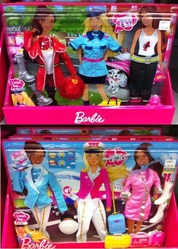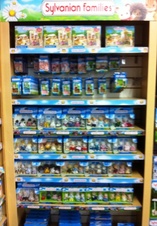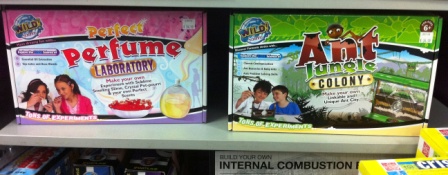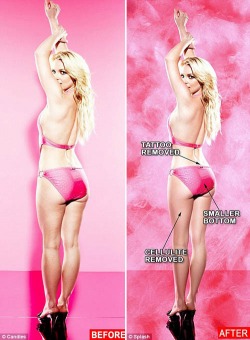|
I have fond memories of my collection of childhood toys - wooden blocks, Big Ted, My Little Pony, the Cindy doll my parents bought me (instead of the Barbie I REALLY wanted), Lego, railway tracks... And nowadays I enjoy sometimes escaping into the imaginary world with my four-year-old boy and his collection of treasured toys. I read about the toys on offer for kids, I see kids playing with toys and the students I work with tell me about the toys that are and were important in their lives. There is a lot of writing about the highly gendered and also sexualised nature of many childhood toys these days, but on Friday I suddenly realised that I could count on one hand the number of times I have been in a toy store since entering adulthood. Inspired by other writers, I decided it was time to hit the front-line. What was on offer for New Zealand children? Was it as bad as it was in the USA? (where much of the research I read comes from) And what are the 'good' options out there? Armed with my camera, I entered our local toy store (one of a nationwide chain). And thus began an hour of walking up and down every aisle, taking note and photographing the good, the bad and the plain downright ridiculous. Into 'GIRL ZONE'  Upon entering the store, the first thing I noticed was that there was an area labelled ‘Girl’s Zone’, but the only other zone to be labelled was 'Pre-school'. Is this because all the other toys in the store are designed for boys (the default ‘normal’), or is it that all the other toys are for both boys AND girls but this wee corner is for girls only? I headed over to investigate further and was nearly blinded by the pink-ness. First up, the Barbie display...  "Hmmm, who do I want to be today?" I had high hopes for the Barbie 'I Can Be..." range. I recall as a child in the 1980s Barbie was a real 'girls can do anything' kinda gal, so I thought that surely by 2012, any remnants of that 1952 original passive doll would be well and truly banished. Unfortunately it seems that Barbie's career options in 2012 are very limited to what she can do whilst still wearing form-fitting lycra and/or heels. And the ubiquitous pink of course. There were five career options in the character dolls (see below) - I challenge anyone to find me any real-life professional woman whose wardrobe resembles any of these outfits?! And as someone who spent my teen years as a surf lifeguard, it sure as hell didn't resemble this Barbie scene. A friend was telling me recently that she had relented and had promised her daughter a Barbie as long as she could find one doing 'normal' things - such as snowboarder Barbie. There wasn't a snowboarder Barbie in this shop, but I can envisage her ensemble already...  And if you wanted to simply give your exisiting Barbie a new career, you had six different outfits to choose from. As you would never guess the occupations from their outfits, let me label them top to bottom, left to right:
Next to Barbie was the much criticised new line of Lego, designed especially for girls - the 'Friends' range. Their catch-phrase is "The Beauty of Building" - because we wouldn't want girls to forget for a moment that regardless of the activity, it always comes down to beauty, right?  Anyone for Disney Princess paraphernalia? I personally dislike this range from Lego. I dislike the emphasis on beauty and I hate that the 'Friends' range have totally different bodies to the 'standard' range - they have boobs and makeup. There is no way one of the 'Friends' would EVER want to play with a standard Lego boy or girl! It's problematic that in creating a specific 'girls' range, by default the rest of the Lego range becomes a 'boys' range, thus limiting girls' options. And the narrow range of activities and colours offered to the girls drives me nuts. There is absolutely no scientific evidence to indicate that girls have a natural inclination towards pastel colours. Lego is just playing into the pinkification of girl-world that serves to further the gender gap amongst children and thus increase the profits of those marketing things to children. Next up was the Disney Princess Zone. In a moment of marketing genius, this line was released in 2000 and now there are now more than 25,000 Disney Princess items and many other companies have jumped on board to create Princess-mania in girl world. Lyn Mikel Brown, co-author of Packaging Girlhood, is concerned by the the sheer dominance of princess culture: “When one thing is so dominant, then it’s no longer a choice; it’s a mandate, cannibalizing all other forms of play. There’s the illusion of more choices out there for girls, but if you look around, you’ll see their choices are steadily narrowing.” As I continued to wander round 'Girl's Zone' I found more and more pink washing, and more and more toys with come-hither eyes and sexy poses. What really struck me was how much some of these toys had changed since I was a girl. In my day 'My Little Pony' was a sweet chubby thing with demure eyes. Her latest incarnation is decidedly sexy, curvy and oh, those eyes. There were a few brands in 'Girl's Zone' that really stood out in a positive way: Venturing out of 'Girl Zone', I headed towards the 'Pre-school' zone... I was pleased to see the gender-neutral 'preschooler' sign, although interested in the offerings as many of the toys in the 'Girl's Zone' were aimed at the pre-school age group. This section gave the impression of being very gender-neutral, but upon closer inspection, many of the toys revealed themselves to be playing into tired gender stereotypes: However, there were also some great non-gender-limiting options: (No other 'zones' were labelled, so the following categories are ones that I have used) Puzzles and games Of all the different types of toys, I would have thought that this genre would have the least need to be gendered. Apparently not. I think the biggest issue with gendering things like this is that it strongly discourages cross-gender play. Unfortunately I feel that few four year old boys would want to play with the pinkified versions of these games. By then, for many boys the gender message has been well and truly absorbed. Outdoor toys  A WINNER from Little Tikes! Gender neutral packaging PLUS an image of a boy and a girl playing together! *calm down Rachel, keep in mind how ODD it is that this is so rare!* Building and Science Sets These were located in the area I think a child would describe as the 'Boys' Zone' (although there were no actual signs to indicate this). Alongside these sets seemed to be an overwhelming collection of toys based around themes of fighting and violence. As the mother of a little boy, I am disturbed by the messages these toys give him about what it means to be a man. I could not find a single toy in this area that depicted a boy or a man in a caring or nurturing role. Play is one way children learn about what it means to be an adult as they role-play with the toys provided to them. What are the consequences of raising a generation of boys whose understanding of manhood is based on ninjas, soldiers and Avengers? My little adventure into the toy store was both depressing and comforting.
Depressing because of the overwhelming number of gender-limiting options out there. I imagined my four year old son Sol being let loose in that store to explore and admire the toys available to him. He would be confronted with SO MANY gender-limiting stereotypes. He would be presented with a very clear picture of what it is to be a girl, and what it is to be a boy. Both of these definitions are very narrow, and he would quickly realise it was high time he dumped all of his female friends. I would label very few of the toys in this shop inherently "bad or "wrong", but it's the overwhelming message they present en masse, and also the stark reality of what is missing. I managed to find three images of girls and boys playing together IN THE WHOLE STORE. Research shows that cross-gender play in childhood increases the likelihood of more healthy romantic relationships in the teen years, yet it seems that marketers are doing all they can to prevent this. Comforting because I realised that, if I searched hard enough I could find toys and games that were not gender-limiting. There are options out there for parents willing to take the time to find them. Some companies are still marketing their product to both genders, and although many had fallen into the highly-gendered trap, a number still offered a 'gender neutral' option alongside their gendered stuff. For this, I am heartened, and this quote comes to mind: "Don't tell me where your priorities are. Show me where you spend your money and I'll tell you what they are." - James W. Frick Childhood lasts for such a precious short time, let's not shorten this further by placing limitations on who and what our children can be. Let's not allow the financial motivations of toy companies have any part in how our children define themselves. Let's give our children the time and the space to explore and experience their world without being limited to what pop culture dictates is "right" for their gender.
7 Comments
I am fascinated by the way media portrays gender. Particularly gender as it applies to children. The images, the colours, the words. As the mother of an almost-three-year-old boy, I am becoming increasingly aware of the gender-limiting stereotypes he is surrounded by. Many of my son's favourite past-times are what toy companies would tell me is "typical boy behaviour" - any random stick becomes a gun, he loves nothing more than rolling on the floor wrestling with his Dad, he is fearless of heights and water, and he is fiercely competitive. But what all toy marketers seem to ignore is that my boy also loves cooking, "helping" fold laundry, wearing jewellery, vaccuming, dressing up and painting his nails. Yesterday I discovered that Canadian Chrystal Smith had created a word cloud comprising of the words used in television advertising for children's toys. Two word clouds were created - one for toys aimed at boys, and one for toys aimed at girls: I stared at these two images for ages.
I love that 'fun', 'magic' and 'love' are the top words used for girls. I don't love it that these are closely followed by a whole lot of words pertaining to beauty and fashion. I don't mind that 'battle' and 'power' dominate the words used for boy's toys - I enjoyed many hours immersed in imaginary wars as a child. But it really concerns me that I can't see any words relating to caring, nurturing or relationships. I haven't stopped wondering since I saw these - will the TV advertisements in NZ show a similar picture? This is my homework this weekend. Watch this space! The words we use create our reality and shape our perceptions. Today's children are the most marketed-to generation of all time and the words they hear have a huge impact on their values and beliefs. Looking at the words used to market prized possessions to them makes me very angry about the reality we are creating for our kids. Thanks to Dannielle Miller for pointing me to this video. A powerful statement on the media's portrayal of women. It sent chills down my spine and tears to my eyes.  Britney Spears It’s not often (ever?!) that I am heard uttering the words “Good on you Britney”, but today, I think Britney Spears has done good. She agreed to let the UK's Daily Mail release un-airbrushed images of herself next to the digitally-altered versions. They say "the 29-year-old singer made the extraordinary move in order to highlight the pressure exerted on women to look perfect". I spent some time looking at these photos, comparing the 'before' and 'after' shots and am amazed at how extensively every blemish and "not perfect" aspect is corrected. The dry skin is covered, the bruises are banished. Even Brit's muscles have been smoothed over and 'minimised', and the *ahem* 'camel toe' dealt to. With glossy magazines and bill boards taunting women with impossible beauty it is great to actually see the full extent of how we are being deceived by the use of digital enhancement. On a conscious level, I know that most magazine and advertisements featuring scantily clad women are airbrushed. On a subconscious level, I still find myself marvelling at the petite bottoms, incredibly long legs and flawless bellies. I am long past aiming for such “flawless perfection” and have even come to love my belly that always has and always will have a slightly-pregnant pose to it. But as a teenager facing these billboards and glossy pictures, I remember having such a distorted view of my body. At 14, I went bikini shopping and spent hours in front of shop mirrors in countless numbers of size 8 bikinis grabbing every piece of “fat” (read: skin fold), only to finally conclude that I was definitely too fat to wear a bikini and went home empty handed. It makes me sad to think that I, age 14, incredibly fit and swim training up to 16 hours a week, was so sucked in by the media portrayal of ‘beauty’ to think of myself as too fat to wear a bikini. (But it also makes me smile when I throw on my a-few-sizes-bigger-than-an-8 bikini now!) My heart goes out to the girls growing up now, in a society so much more saturated by mass media and commercialism than it was in my childhood. Countless studies have shown a direct link between the media’s portrayal of beauty and body image disorders such as bulimia and anorexia. These disorders are increasing at a disturbing rate. We need to get real about the unrealistic images of “beauty” that are so prevalent in the media. So I thank you Britney for showing the world that in fact you do have dimply thighs. You don’t have a concave belly or shiny skin and you even get bruises on your legs like the rest of us. I hope more celeb’s follow suit. In fact, I hope this starts the tide of people demanding that we see REAL people in our magazines and advertisements. Getting rid of digital enhancement is an unrealistic request, but what I want to see alongside all future airbrushed images is a statement like this: “This woman’s body has been digitally enhanced. She really has dimply thighs, a cute sticky-outy belly and a small scar on her knee, but we were worried you wouldn’t buy our product if you saw those humanising features” “What do you do?”
I lose track of how many times I am asked this in a week. Maybe it has always been so, but I think previously my answer to this has been somewhat simpler, so I hadn’t noticed the regularity to which I was asked this. At various times I have answered with: I am studying. I am a management consultant. I am a recruitment consultant. I am a children’s party fairy. I am a surf lifeguard. I am a traveller. I am a counsellor. I am a teacher.I am trying to decide what I am going to be when I grow up. But now, “what I do” is so much harder to define. A man asked me this question on Sunday. I mentioned a couple of things that I “do”, at which point he interrupted and said he didn’t need my CV. I was a little taken aback – I had only just started! : ) I think that for this man, the question was a superficial nicety, he didn’t really want to know. Particularly once I had uttered the word ‘sexuality’... But it got me thinking – can I sum up “what I do” in a short, concise socially acceptable sentence? I thought long and hard, and decided “no”. But I did think that it was a good topic for a blog post. I am just getting started in the blogosphere and I thought it would be apt to define “what I do” at this early stage. First and foremost, I am a mother. This is my most important role and the one that will always take priority – for the rest of my life. This is my grounding principal and I will never apologise to anyone if this role interrupts other things I am ‘supposed’ to be doing. Being a mother is a huge privilege and my child only has one of me. (NB. The value our society places on this role is a whole post in itself, coming soon!) I provide education around sexuality - I teach in schools, I run workshops for parents and youth. I want every person to love, value, respect and understand their whole body. I write. I am currently writing for Birthright NZ, redeveloping their website and increasing their profile. I love it that my work will help and raise awareness of the fantastic job that so many one-parent families are doing around the country. I educate and empower local business women with their online presence and run workshops on social media. This was something that evolved, rather than a conscious decision to get involved in this area. It is so rewarding to see women who had shied away from such things become confident and innovative online networkers. I mentor young women. This is a huge privilege and one of the most inspiring parts of any week. I read. Current topics of interest are body image and the media... advertising to youth... the sexualisation of children... alcohol and pregnancy... how social media can help not-for-profits and small businesses... worm farming... sustainable living. And now... I blog. Increasingly so. My goal is three posts a week. Help keep me honest ; ) As soon as we found out that I was pregnant, we told our three-year-old son Sol about my pregnancy and involved him in all the midwife appointments. He recently accompanied us to the 20-week scan. After the radiographer had done all the important measurements and observations, she got to the least important part – finding the vulva or the penis. As she was looking for that part of our baby’s body she said to me “Ouhhh, you’ll soon know if you’ll have to be buying a pink tutu!” (I am sure my husband smothered a laugh at this point. I refrained from launching into a tirade about gender stereotyping and the findings of various neurological studies on babies and gender.) As it turns out, we spotted a vulva. And I realised that, at 20 weeks gestation this wee girl had already experienced her first gender stereotyping. It isn’t that pink tutus violently offend me. It's that there was an assumption that if my baby had a vulva, then buying a pink tutu would be the most important consideration and that her vulva would automatically predispose her to an uncontrollable urge to wear pink tutus. Who knows, perhaps she will be an absolute ballet fanatic, in which case I am sure our house will be loaded with tutus of all description. Or she could be a soccer player, a hip-hop dancer, a chess-genius, a swimmer... - in which case we may have no pink tutus at all. Or maybe she’ll have stages of being all of the above, and our already cluttered house will have a collection of all sorts of outfits in all sorts of colours. All I do know is that I will do everything in my Mama-Bear power to protect my daughter from all the gender-limiting stereotypes that will attempt to smother her from birth (and before!). Suddenly I am hugely grateful on a personal level to those dedicated organisations and people who are out there campaigning on behalf of our girls - Enlighten Education, 7Wonderlicious, Pigtail Pals Ballcap Buddies, Pink Stinks and many more. I will leave you with little Riley, who articulates my feelings just so well: |
AuthorRachel is a writer and educator whose fields of interest include sexuality education, gender, feminism and youth development. Archives
November 2023
Categories
All
|











































 RSS Feed
RSS Feed




